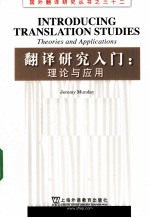

翻译研究入门 理论与应用PDF电子书下载
- 电子书积分:10 积分如何计算积分?
- 作 者:戴炜栋著
- 出 版 社:上海:上海外语教育出版社
- 出版年份:2010
- ISBN:9787544617383
- 页数:224 页
Introduction 1
1 Main issues of translation studies 4
1.1 The concept of translation 4
1.2 What is translation studies? 5
1.3 A brief history of the discipline 7
1.4 The Holmes/Toury'map' 10
1.5 Developments since the 1970s 14
1.6 Aim of this book and a guide to chapters 15
2 Translation theory before the twentieth century 18
2.0 Introduction 18
2.1 'Word-for-word'or'sense-for-sense'? 19
2.2 Martin Luther 22
2.3 Faithfulness,spirit and truth 23
2.4 Early attempts at systematic translation theory:Dryden,Dolet and Tytler 24
2.5 Schleiermacher and the valorization of the foreign 27
2.6 Translation theory of the nineteenth and early twentieth centuries in Britain 28
2.7 Towards contemporary translation theory 29
3 Equivalence and equivalent effect 35
3.0 Introduction 35
3.1 Roman Jakobson:the nature of linguistic meaning and equivalence 36
3.2 Nida and'the science of translating' 37
3.3 Newmark:semantic and communicative translation 44
3.4 Koller:Korrespondenz and ?quivalenz 46
3.5 Later developments in equivalence 49
4 The translation shift approach 55
4.0 Introduction 55
4.1 Vinay and Darbelnet's model 56
4.2 Catford and translation'shifts' 60
4.3 Czech writing on translation shifts 62
4.4 Van Leuven-Zwart's comparative-descriptive model of translation shifts 63
5 Functional theories of translation 72
5.0 Introduction 73
5.1 Text type 73
5.2 Translational action 77
5.3 Skopos theory 78
5.4 Translation-oriented text analysis 81
6 Discourse and register analysis approaches 89
6.0 Introduction 89
6.1 The Hallidayan model of language and discourse 90
6.2 House's model of translation quality assessment 92
6.3 Baker's text and pragmatic level analysis:a coursebook for translators 95
6.4 Hatim and Mason:the semiotic level of context and discourse 99
6.5 Criticisms of discourse and register analysis approaches to translation 101
7 Systems theories 108
7.0 Introduction 108
7.1 Polysystem theory 109
7.2 Toury and descriptive translation studies 111
7.3 Chesterman's translation norms 118
7.4 Other models of descriptive translation studies:Lambert and van Gorp and the Manipulation School 119
8 Varieties of cultural studies 126
8.0 Introduction 127
8.1 Translation as rewriting 127
8.2 Translaion and gender 131
8.3 Postcolonial translation theory 133
8.4 The ideologies of the theorists 138
9 Translating the foreign:the(in)visibility of translation 144
9.0 Introduction 144
9.1 Venuti:the cultural and political agenda of translation 145
9.2 Literary translators'accounts of their work 152
9.3 The power network of the publishing industry 153
9.4 Discussion of Venuti's work 155
9.5 The reception and reviewing of translations 156
10 Philosophical theories of translation 162
10.0 Introduction 162
10.1 Steiner's hermeneutic motion 163
10.2 Ezra Pound and the energy of language 168
10.3 The task of the translator:Walter Benjamin 169
10.4 Deconstruction 170
11 Translation studies as an interdiscipline 181
11.0 Introduction 181
11.1 Discipline,interdiscipline or sub-discipline? 182
11.2 Mary Snell-Hornby's'integrated approach' 183
11.3 Interdisciplinary approaches 187
11.4 The future:co-operation or fragmentation? 190
Appendix:internet links 197
Notes 198
Bibliography 203
Index 213
Figures 10
1.1 Holmes's'map'of translation studies 10
1.2 The applied branch of translation studies 13
3.1 Nida's three-stage system of translation 40
5.1 Reiss's text types and text varieties 74
6.1 Relation of genre and register to language 90
6.2 Scheme for analyzing and comparing original and translation texts 92
7.1 Toury's initial norm and the continuum of adequate and acceptable translation 114
7.2 Preliminary norms 115
7.3 Operational norms 115
11.1 Text type and relevant criteria for translation 184
Tables 45
3.1 Comparison of Newmark's semantic and communicative translation 45
3.2 Differentiation of equivalence and correspondence 47
3.3 Characteristics of research foci for different equivalence types 48
4.1 Main categories of van Leuven-Zwart's comparative model 64
4.2 Segmentation of text into units of translation 67
5.1 Functional characteristics of text types and links to translation methods 74
- 《SQL与关系数据库理论》(美)戴特(C.J.Date) 2019
- 《钒产业技术及应用》高峰,彭清静,华骏主编 2019
- 《红色旅游的社会效应研究》吴春焕著 2019
- 《汉语词汇知识与习得研究》邢红兵主编 2019
- 《现代水泥技术发展与应用论文集》天津水泥工业设计研究院有限公司编 2019
- 《生物质甘油共气化制氢基础研究》赵丽霞 2019
- 《东北民歌文化研究及艺术探析》(中国)杨清波 2019
- 《联吡啶基钌光敏染料的结构与性能的理论研究》李明霞 2019
- 《异质性条件下技术创新最优市场结构研究 以中国高技术产业为例》千慧雄 2019
- 《HTML5从入门到精通 第3版》(中国)明日科技 2019
- 《培智学校义务教育实验教科书教师教学用书 生活适应 二年级 上》人民教育出版社,课程教材研究所,特殊教育课程教材研究中心编著 2019
- 《习近平总书记教育重要论述讲义》本书编写组 2020
- 《办好人民满意的教育 全国教育满意度调查报告》(中国)中国教育科学研究院 2019
- 《教育学考研应试宝典》徐影主编 2019
- 《语文教育教学实践探索》陈德收 2018
- 《家庭音乐素养教育》刘畅 2018
- 《学前教育学》王换成主编 2019
- 《近代体育游戏教育史料汇编 第1辑 1》王强主编 2016
- 《全国学前教育专业(新课程标准)“十三五”规划教材 简谱手风琴教程 第2版》(中国)杨克勤,王宝庆 2019
- 《现代教育技术》李志河主编 2019
